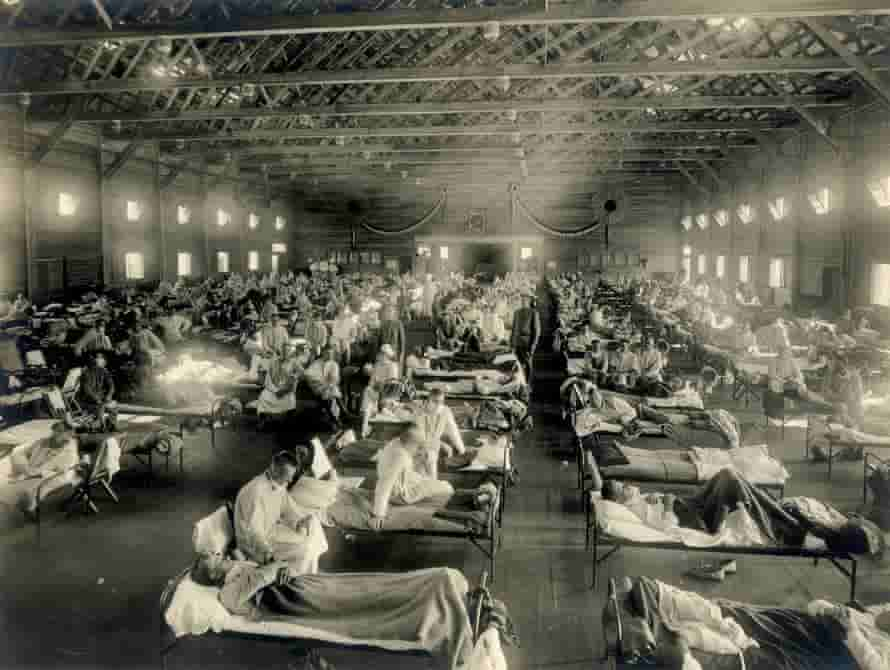The COVID-19 pandemic has killed more Americans than the Spanish flu pandemic in 1918-19 did. According to Johns Hopkins University, more than 676,000 have died in the U.S. due to the novel coronavirus, making it the deadliest pandemic of the 20th century.
The latest COVID-19 death toll surpasses the death toll of the 1918 flu, which is estimated to have killed 675,000 Americans, according to the U.S. Centers for Disease Control and Prevention.
Epidemiologist Stephen Kissler of the Harvard T. H. Chan School of Public Health said that the population in the United States is now triple what it was in 1918. So while the death toll from COVID-19 may be higher, the 1918 flu pandemic killed a higher proportion of Americans.
Back in 1918, there was no flu vaccine to fight the disease, according to the CDC. But currently, COVID-19 vaccines are available that can help reduce risks of severe infection, hospitalizations and deaths. However, there are many people who are refusing to get vaccinated despite rising coronavirus cases in the country.
“Big pockets of American society — and, worse, their leaders — have thrown this away,” medical historian Dr. Howard Markel of the University of Michigan said pertaining to the opportunity we have right now to vaccinate everyone eligible.

According to Emory University biologist Rustom Antia, a positive scenario of the COVID-19 becoming cold is not guaranteed and could happen in a few years’ time. “We hope it will be like getting a cold, but there’s no guarantee.”
Currently, the U.S. is still averaging about 2,000 deaths, which is approximately two in every 1,000 people. In comparison, the death rate from the Spanish flu was six in every 1,000 residents, a blog posted by E. Thomas Ewing on Health Affairs stated.
The University of Washington’s influential model predicted that an additional 100,000 or even more Americans will succumb to the COVID-19 virus by Jan. 1. This will bring the total U.S. death toll to 776,000.
Globally, the Spanish flu pandemic killed over 50 million people. But during that time, the world had only one-quarter of the population than what we have now. The COVID-19 deaths globally are now over 4.6 million.
The COVID-19 may fade only if the virus gradually weakens while it mutates, and if our immune systems could learn to attack the virus. Getting the vaccine and surviving the infection are the main ways the immune system improves and strengthens. Infants who are breastfed can also acquire some immunity from their mothers.
Only under 64% of the U.S. population has received at least one dose of the vaccine. States like Vermont and Massachusetts has about 77% vaccination rate while only 46%-49% have received at least a dose of the vaccine in Idaho, Wyoming, West Virginia, and Mississippi.
Worldwide, according to Our World in Data, only 43% of the population has received at least a dose of the vaccine. African countries are just starting to administer their first shots.
According to Dr. Jeremy Brown, the director of emergency care research at the National Institutes of Health said that all pandemics will eventually end but “they can do terrible things while they are raging.”
Brown also said that the virus could have been less deadly in the U.S. if more people received their vaccine faster. “and we still have an opportunity to turn it around…We often lose sight of how lucky we are to take these things for granted.”
The vaccines available now work well in preventing severe disease and death from all the variants of the COVID-19 virus that have surfaced so far.
According to Ann Marie Kimball, a retired professor of epidemiology at the University of Washington, COVID-19 mutates slower compared to flu viruses which makes it more a stable target for vaccination.
Also Read: FDA Panel Disapproves Biden’s Plan For COVID-19 Booster Shots


